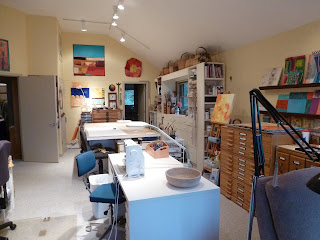by Jo Reimer
A Change of Scenery, indoors
I've been rearranging my studio, never an easy process but one that's necessary now and then. I find that a change in the scenery can trigger motivation to work whether the scenery change is a walk through someone else's neighborhood, being a passenger for a Sunday afternoon drive into the country, or changing one's own physical surroundings.
Floor Plugs, love 'em or hate 'em
When we designed this house I asked for floor plugs in the studio and in the living room so I wouldn't have electric cords snaking across the floor. I got the plugs and they were okay for the first few years until I reverted to my natural inclimation to rearrange furniture. Now I have extension cords attached to the floor plugs and have had to teach myself not to trip over them.
This studio has seen three major shifts in layout.
It was designed to be a quilting/sewing studio and it was perfect for about six years, was even featured in Rainey-Black's Dream Sewing Spaces. The author is an interior designer specializing in kitchen planning, concepts which directly apply to studio planning as far as cabinetry and workspace is concerned and she helped me with arrangement of equipment in the studio space.
Shooting the pictures for this book was a hoot. My studio is a huge loft above the garage and looks over our home's public spaces. At one point the photographer stood on a tall ladder in the living room in order to shoot this picture.
 |
| Sewing Studio 1995 |
Then in 1998 I sold my pattern business, Saf-T-Pockets, and started drawing and painting so the studio arrangement needed to change.
Recently I needed a dedicated reading corner. I have built-in shelves under the corner windows that give me a garden and sky view. the corner hadn't served a good purpose since I removed the shipping station and was most often a catch-all sort of space.
Reading Corner
 |
| Reading corner, before |
 |
| Reading corner, after |
Tables
 |
previous arrangement of my 3 large tables
Table: 4x6 ft. with 2 24" drop leaves |
 |
| large painting table with easel and flat files. |
Counter and Desk
 |
| 33" deep counter |
 |
| the counter ends at my desk which is always a mess. |
You might wonder about the neon sign. My daughter spotted the neon sign stored in a friend's garage and traded a crib and baby clothes for it.
Library
 |
| Library |
These are all art books, arranged by type: book-binding and art journals, drawing, oil, acrylics, watercolor, artists, art, with the few remaining quilting and sewing books on the lowest shelf. the two upper shelves on the right are studio journals which I've filled over the last 20 years.
 |
| cluttered but organized |
Present Arrangement
Moving that big table requires muscle even though it's on wheels. The wheels should be larger and as we were muscling it across the room one wheel broke off. We waited for sons and grandson to visit and the younger guys lifted the corner while my husband put a block underneath. Something tells me that this table will never move again.
I turned the collage table around and butted it up against one of the 30 x 60 tables. This will be my sit down station for collage and watercolor and for working in journals. I can turn my desk chair around and work from there, too. The sewing station is on the other 30 x 60 table, lower right of the picture, but since I don't sew much now it'll be another workspace for whatever I need.
So that's it. All that's left to do is to tame the clutter on my desk and counter and get to work making art. Right now I just want to make art... so I will.
Advice gained from experience
Not everyone gets to have a dream studio like my present one.
For the first 10 years of our marraige I had NO studio. I worked out of boxes and baskets on the kitchen table or in my lap. Then we moved to a larger house and I used a room that doubled as laundry room and dining room, thanks to appliances and art supplies stored in built-in cabinets.
The next move allowed me to have a tiny nook off the kitchen to use as a studio. Then I moved to a spare bedroom, and eventually to the rec room after our kids left home.
We designed and built our present house, complete with my wonderful studio, 20 years ago, and thanks to my favorite architect I have the space I need.
Makes do with what you have.
I heard that when wearables artist Yvonne Porcella started out she had only the top of the washing machine on which to work. So she designed clothing that was made up of modules, none larger than the washing machine.
If I ever have to move from here I'll think seriously about renting a studio... or make small art.
Divide your work space into stations
- even if you have only a desk or several baskets. designate what activity happens in or out of each... drawing, cutting, painting, sewing, shipping.
- Put your tools and supplies at the point of first use... if you're right handed put your scissors and pens on the right side. Keep your paints and mediums within reach in your painting station, not across the room.
- Buy several pairs of scissors and have one in each station so you don't have to walk across the room to find a pair.
Don't use your studio for inactive storage. that's what the basement is for.

















